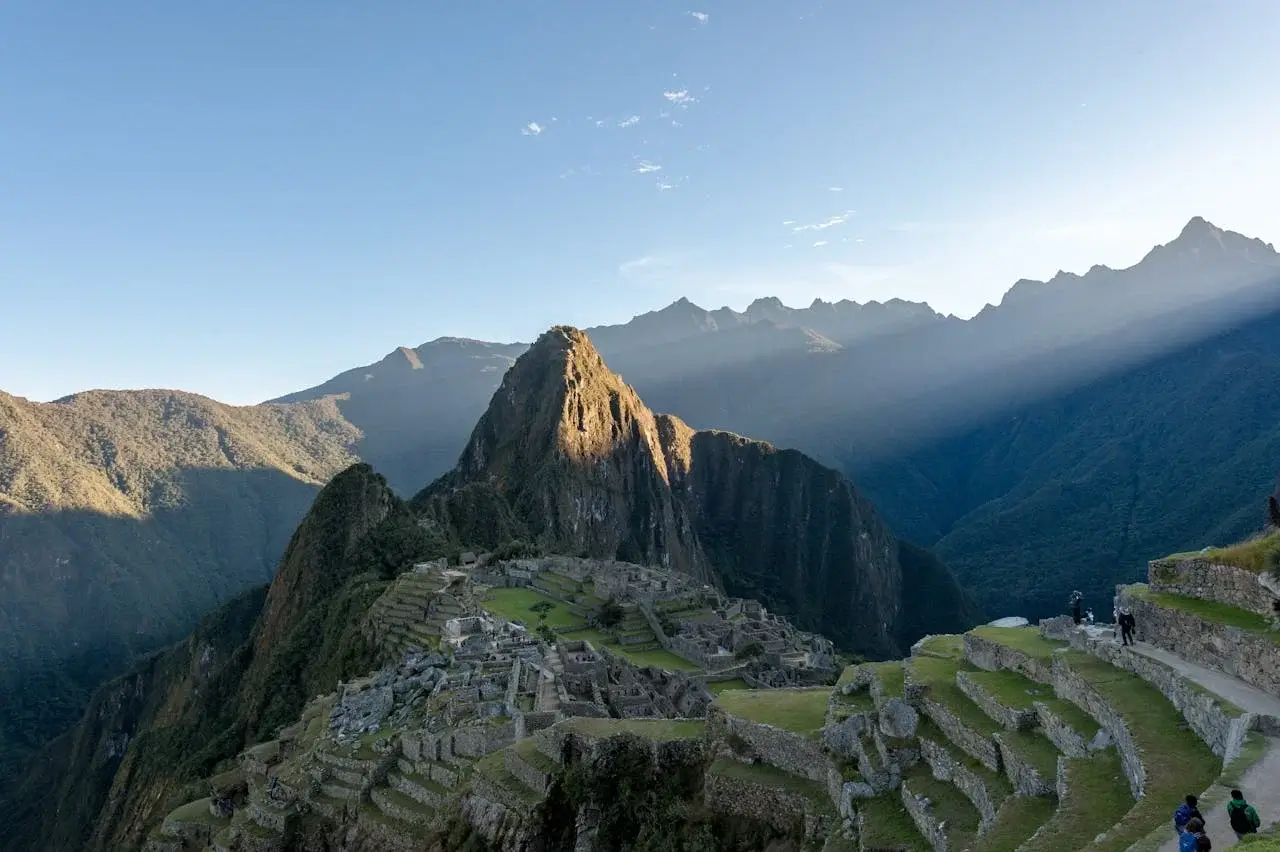Traveling through the Andes means ascending into a world where history meets breathtaking landscapes — quite literally.
The altitude difference between Cusco (3,399 m / 11,152 ft) and Machu Picchu (2,430 m / 7,972 ft) shapes not just your itinerary but also your experience.
At Andean Travel Experience, we ensure your journey through Peru’s elevations is as seamless as it is extraordinary balancing comfort, luxury, and adventure.
“Luxury travel in Peru begins with understanding the rhythm of the Andes and moving with it.”
Cusco’s Elevation: The Gateway to the Andes
At 3,400 meters (11,152 feet) above sea level, Cusco is one of the highest continuously inhabited cities in the world and the historic capital of the Inca Empire. Its cobblestone streets, grand plazas, and mountain vistas make it both majestic and humbling.
But its elevation can also take your breath away literally.
Quick facts:
- Altitude: 3,399 m (11,152 ft)
- Climate: Cool and dry, 5°C–20°C
- Must-see: Qorikancha Temple, Sacsayhuamán Fortress, and San Blas neighborhood
- Experience: Explore cobbled streets, artisan shops, and gourmet dining
“Cusco is not just a destination it’s a state of elevation.”
🟢 Travel Tip: Spend 2 nights in Cusco to gently acclimatize before exploring Machu Picchu.
Discover Cusco’s timeless charm with a tour.
Machu Picchu: The Lost City at a Lower Altitude
Descending from Cusco to Machu Picchu feels like stepping into another world lush, green, and mystical. Located at 2,430 meters (7,972 feet) above sea level, it sits significantly lower, offering easier breathing and milder conditions.
Quick Facts:
- Altitude: 2,430 m (7,972 ft)
- Climate: Subtropical, 12°C–25°C
- Location: Between the Andes and the Amazon Basin
- Experience: Explore the lost city at sunrise, hike Huayna Picchu, or relax in Aguas Calientes
“Descending from Cusco to Machu Picchu feels like stepping from the heavens into paradise.”
🟢 Travel Tip: If you feel altitude discomfort in Cusco, you’ll likely feel better once you reach Machu Picchu.
Get Inspired with our Machu Picchu Tours Page or our blog Best Time to Visit Machu Picchu.
Cusco vs Machu Picchu: Altitude Comparison Table
| Location | Altitude (Meters) | Altitude (Feet) | Oxygen Level | Climate |
|---|---|---|---|---|
| Cusco | 3,399 m | 11,152 ft | ~65% of sea level | Cool & dry |
| Sacred Valley | 2,800 m | 9,186 ft | ~73% of sea level | Mild & sunny |
| Machu Picchu | 2,430 m | 7,972 ft | ~78% of sea level | Warm & humid |
🟢 Takeaway: Cusco is almost 1,000 meters (3,200 feet) higher than Machu Picchu. This means most travelers feel better once descending to Machu Picchu after spending time acclimating in Cusco.
View our Sacred Valley luxury retreats
How Altitude Affects Your Body and How to Prepare
When you arrive in Cusco, the thin mountain air can cause mild symptoms like:
- Headache or dizziness
- Shortness of breath
- Fatigue or sleeplessness
These effects usually fade within 24–48 hours as your body adjusts.
Expert tips:
- Arrive gradually: Spend your first night in the Sacred Valley (lower altitude) before Cusco.
- Hydrate constantly: Water helps your body adapt faster.
- Eat light: Avoid heavy meals and alcohol early on.
- Coca tea: A traditional Andean remedy available everywhere.
What Happens at Altitude:
- Less oxygen in the air
- Increased heart rate and breathing
- Mild headaches or dizziness (temporary)
Fact: Around 30–40% of travelers to Cusco experience mild altitude symptoms that usually fade after a day or two.
“The Andes teach you patience one breath at a time.”
Tips to Prevent Altitude Sickness
Recommended Habits:
- Stay hydrated sip water throughout the day
- Drink coca or muña tea, traditional Andean remedies
- Avoid alcohol and heavy meals for the first 24 hours
- Sleep well and allow your body to adjust naturally
- Consult your doctor about acetazolamide (Diamox) before traveling
Practical steps to enjoy your trip comfortably:
- Spend 2–3 days in Cusco or the Sacred Valley before heading to Machu Picchu.
- Consider visiting Pisaq or Ollantaytambo for lighter exploration days.
- Travel with expert local guides who know the best pacing and rest stops.
🟢 Luxury Tip: Choose hotels in Cusco and the Sacred Valley offering oxygen-enriched rooms and herbal infusions.
View our blog on How to Avoid Altitude Sickness in Cusco
Cultural Insight: The Incas’ Mastery of the Heights
The Andes were their temple, altitude their ally. The Incas built their empire across staggering elevations from the Sacred Valley to the peaks above 4,000 meters.
Cultural Highlights:
- Cusco: The “navel of the world,” symbolizing connection to the heavens.
- Machu Picchu: A royal estate and sacred sanctuary to the gods.
- Engineering: Terraced agriculture and precise stonework adapted perfectly to mountain terrain.
“For the Incas, altitude was not an obstacle it was sacred alignment with the divine.”
🟢 Takeaway: Every step at high altitude retraces paths the Incas once walked, perfectly attuned to the land.
Luxury Tips for Traveling at Altitude
Experience the heights with comfort, style, and serenity.
Andean Travel Experience Recommends:
- Travel progressively: Cusco → Sacred Valley → Machu Picchu
- Stay in premium hotels with wellness spas and oxygen service
- Dress in layers mornings cool, afternoons warm
- Travel by train the Hiram Bingham or Vistadome for elegance and comfort
- Include relaxation days to fully absorb your surroundings
🟢 Tip: Book a private wellness retreat or yoga session in the Sacred Valley to balance body and mind.
Explore our Peru Tours
Frequently Asked Questions
Is Machu Picchu higher than Cusco?
No. Machu Picchu is lower (2,430 m) than Cusco (3,399 m), meaning it’s easier to breathe there.
How long does acclimatization take?
Usually 24–48 hours. Most travelers feel comfortable after their second day in Cusco.
Can I visit Machu Picchu directly from Lima?
Yes, but we recommend stopping in the Sacred Valley first for a smoother altitude transition.
Do luxury hotels help with altitude?
Yes many offer oxygen-enriched rooms, herbal teas, and spa treatments designed for altitude relief.
Can I get altitude sickness at Machu Picchu?
It’s rare. Most travelers experience symptoms in Cusco, not Machu Picchu.
Should I visit Cusco or Machu Picchu first?
Starting with the Sacred Valley (lower elevation) helps you acclimatize before exploring Cusco.
What’s the weather difference between Cusco and Machu Picchu?
Cusco has a cooler, drier climate. Machu Picchu is warmer and more humid due to its subtropical environment.
At Andean Travel Experience, we design luxury, fully planned itineraries that let you focus on wonder not logistics.
From seamless transfers to handpicked hotels and private guides, every detail is crafted for your comfort.
“You don’t just visit Machu Picchu you feel it, breathe it, and remember it forever.”
Plan your Machu Picchu experience today and let us handle every detail so you can simply enjoy the heights.




